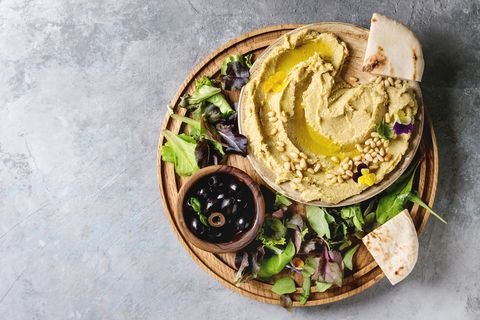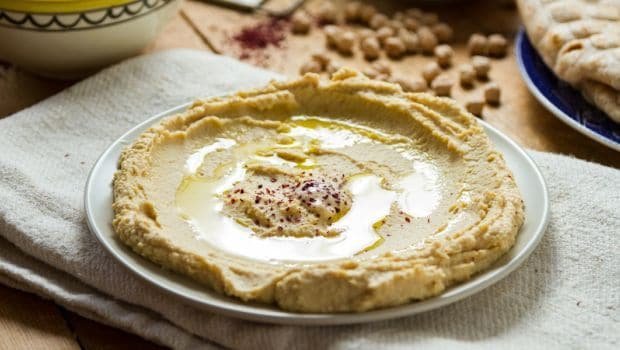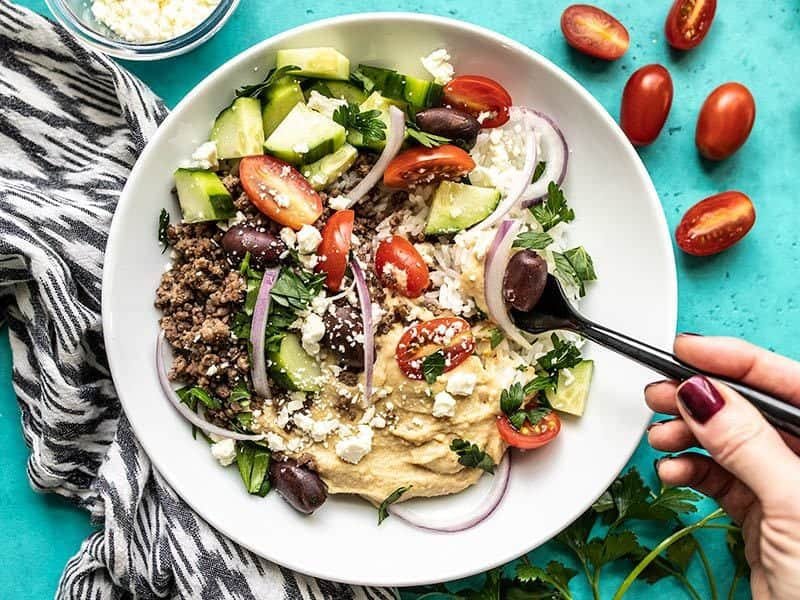
It’s no secret that hummus is one of the most popular dips in the world.
What many people don’t know, however, is what to eat with hummus. It may seem like a simple question – after all it’s just a dip.
However there are actually quite a few different foods that go well with this delicious spread.
In this blog post we’ll explore some of those food items and find out why they work so well when paired with your favorite dip.
There’s no need to feel limited when it comes to eating your Humus dip : there are lots of delicious combinations.
Hummus is a delicious dip that comes from the Middle East.
It can be eaten with vegetables, crackers, or pita bread for dipping. But what do you eat with hummus?
There are many options. Here are some things that go great with hummus:
– Sliced cucumbers and carrots
– Hummus sandwich (with veggies)
– Crispbreads or crackers topped with cheese and pepperoni slices
– Sweet potato wedges seasoned with salt, paprika, chili powder, garlic powder & cumin
– Cucumber and avocado slices
Humus is also best enjoyed with grilled or toasted pita bread, crackers, saltines, and tortilla chips.
To eat it in a sandwich form you will need some type of protein like hard boiled eggs, cheese slices, meatballs or even vegetables such as roasted red peppers.
If you’re looking for something sweet then try dipping your apple into the hummus.
No matter what you’re craving, there are plenty of options for enjoying your favorite dish.
So the next time you open up that pita bread to make yourself a Humus sandwich, remember these tips and see if any suggestions sound like something you might like.
The Benefits of Hummus
Hummus is a delicious and healthy food that can be enjoyed before, during or after a meal.
It tastes great with pita bread, crackers or veggies. But did you know it also has some amazing nutritional benefits?
In this article we will discuss the benefits of hummus and how to enjoy it for optimum health.
Hummus helps to increase the absorption and use of iron.
Iron is important for energy production, proper growth during childhood, and immune function in adults.
It Contains a good amount of essential fatty acids that are necessary for brain development as well as healthy cell membranes throughout your body.
Essential fatty acids also help with blood sugar control, preventing inflammation and promoting healing from wounds or burns.
It Aids in digestion by keeping food moving through your intestines smoothly without causing any pain or discomfort.
Hummus Supports weight management because it is high in protein which can keep you feeling fuller longer after eating (protein takes more time to break down than carbohydrates).
Hummuses rich in fiber provide bulk so you feel full and satisfied.
Protein and fiber in hummus can also help with weight loss by keeping blood sugar levels stable, curbing your appetite, and improving the body’s ability to use insulin correctly for energy storage (insulin resistance).
It Contains Vitamin K that helps keep bones strong as well as bone mineral density high which lowers the risk of osteoporosis.
Hummus Is a great source of folate which is necessary for healthy neural development during pregnancy or infancy.
It Supports liver function because it contains antioxidants such as vitamin E and beta-carotene which may protect against cancer precursors or other toxins found in our environment.
How Many Calories & Carbs Are in Hummus?

It’s no secret that hummus is a popular food.
People love that it has healthy fats and protein, as well as the tasty tahini, lemon juice or red pepper flakes on top.
But how many calories are in hummus? And what about carbs?
I know what you’re thinking, hummus is healthy right?
Well here’s the thing. Hummus can be healthy if you make it yourself with chickpeas and a few other ingredients but most store-bought versions are anything but.
In fact one of the biggest complaints about store bought hummus is that it contains way too many calories and carbs for anyone who wants to lose weight or stay fit.
The average serving size of Humus (about ¼ cup) contains around 80-100 calories and between five to six grams of fat.
The calorie count may vary depending on variations such as added olive oil or garlic clove used during preparation.
However, studies show that one tablespoon provides up to 130 calories with 11g of fat from just two tablespoons of vegetable oil alone—that makes this dip pretty high in both calories and fats.
One serving size may contain anywhere between about 18-24 grams of carbohydrates which equates to a total amount of energy from around 120-150 calories per cup—that’s only 40% more than would be found in one slice of whole wheat bread.
If you want to lose weight or stay fit then try making your own homemade version of hummus with chickpeas instead.
Don’t make too much at once because store-bought versions typically contain way too many calories and carbs for anyone who wants to do either of those things.
What can you eat with hummus to lose weight?

Hummus is typically made with chickpeas, which are a good source of protein.
You can eat hummus as part of your snacks or meals to help you stay full for longer periods and lose weight in the process.
If that sounds like something you would be interested in, then here are some examples of what other foods go well with hummus:
*Vegetables such as carrots, cucumbers, tomatoes etc. (It’s also possible to buy pre-cut vegetables at most grocery stores)
*Pita breads (Be careful not to load up on too much pita since it doesn’t contain many nutrients)
*Celery sticks (Celery contains very little calories and carbs)
*Cucumbers (This vegetable is low in calories and contains no carbohydrates to speak of)
Another thing you can do with hummus is use it as an ingredient for other dishes.
For example, if you’re making a quinoa salad then adding some hummus will make the dish more filling.
Alternatively, if you want to add protein but don’t want meat thrown into your pasta sauce then stirring in some hummus should give you that extra boost without any additional ingredients.
It’s not hard to find pre-made hummus at most grocery stores, but it might be worth your time to make your own if you’re trying to cut back on the amount of sodium and preservatives in store bought versions.
If you buy premade hummus then just make sure that there is no added sugar or fat (that would change those numbers).
When making your own though, try adding some zucchini for extra fiber or olives for a healthy dose of monounsaturated fats.
What is traditionally served with hummus?

Hummus, which comes from the Arabic word “hommus”, is a dip or spread that can be made from chickpeas, tahini, olive oil and lemon juice.
It’s often eaten as an appetizer or side dish to accompany other foods such as pita bread.
It has been said that hummus was invented in ancient Egypt.
The Egyptians created it by blending cooked chickpeas with tahini (sesame paste), garlic and fresh lemon juice.
This mixture was then mashed using a mortar and pestle into a smooth paste called “misr”.
Traditionally, Hummus is served alongside Pita Bread, which are thick, round flatbreads.
Hummus can also be served with various vegetables such as cucumbers or carrots to make a dip that is more like “hummus made easy”.
This kind of hummus is perfect for those who don’t have much time in the kitchen and just want something quick and simple.
A popular form of Hummus-eating involves pouring it into a dish, adding garnishes on top (usually chopped parsley), then eating by dipping pieces of pita bread directly onto the surface.
The fingers should never come into contact with the paste because germs could contaminate it if they do not wash their hands before touching food.
Another common way of serving hummus is to use it as a dip for your favorite chips or crackers that you can find at the store.
This not only tastes great but also saves on calories since there’s no additional oil involved.
You could even make an antipasto platter with some olives, herbed goat cheese and roasted peppers if you want something exciting yet simple to serve.
Finally, one more thing you can do with your leftover tahini sauce (that would be the delicious creaminess in the hummus) is to mix it with plain yogurt and dill weed for a healthy alternative to mayonnaise which makes any sandwich taste better than ever before.
There are many ways to enjoy your hummus.
From pairing it with a sandwich or cracker, dipping vegetables in it, or even topping off a pizza crust for an extra cheesy and delicious meal- there is no wrong way to eat this dip.
How Long Does Hummus Last?

Hummus is a favorite among many people, and it’s no wonder why.
It is a delicious dip that can be enjoyed with pita bread, vegetables or chips for an appetizer before dinner.
However, how long does hummus last?
The answer to this question depends on the type of hummus you have as well as the storage conditions.
There are three main types of Hummus: traditional chickpea-based Hummus (commonly found in Mediterranean countries), white bean-based Hummous (commonly found in Israeli cuisine) and black eyed pea-based Hommus (typically served cold).
All three varieties will keep around 3 days from the date they were opened if stored properly in your refrigerator at 40 degrees Fahrenheit.
If you enjoy Hummus often, it may be a good idea to invest in an airtight container that will seal the flavor in and keep bugs away from your beloved dip for up to six months.
Airtight containers also help prevent moisture loss and spoilage which can lead to rancid flavors.
Remember, always store humus at 40ºF or below with very little humidity otherwise its shelf life is drastically decreased.
